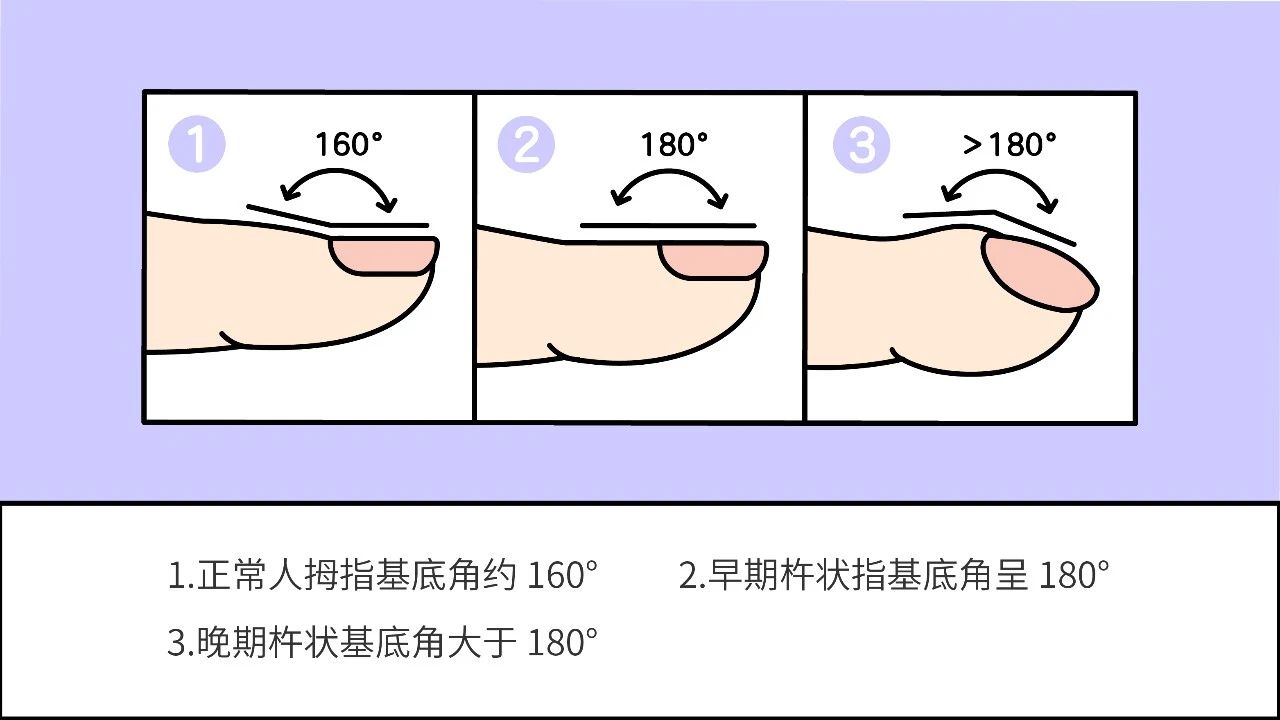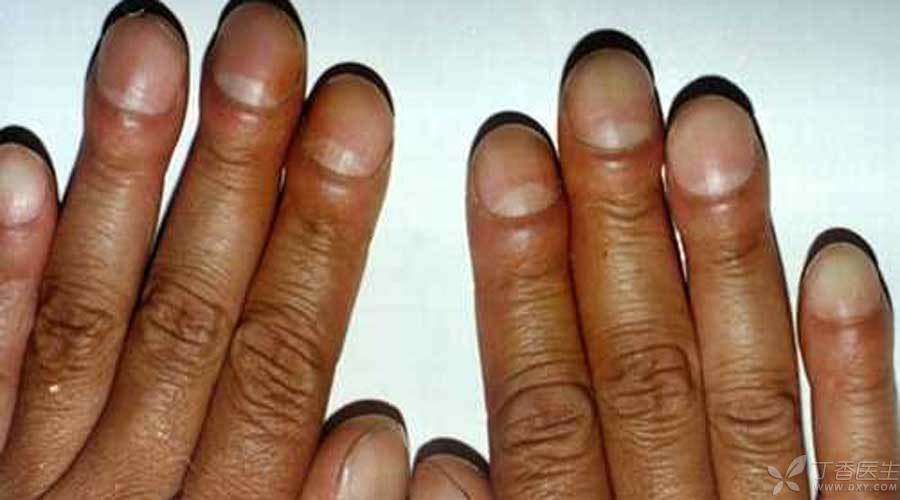Clubbed finger
OVERVIEW
What is clubbing?
Clubbing refers to the bulbous enlargement of the distal fingers or toes, resembling a drumstick, also known as drumstick fingers/toes. In the early stages, the enlarged portion involves small vein and capillary dilation along with tissue edema, while later stages involve tissue hyperplasia.
Clubbing can be either acquired or hereditary.
The distal phalanx becomes noticeably wider and thicker, with the nail curving convexly from the base to the tip, causing the angle between the skin on the back of the fingertip and the nail to equal or exceed 180°.

Image source: Dingxiang Doctor content team
Is clubbing common?
Yes, it is common and can occur in all populations.
Are clubbing and drumstick fingers the same condition?
Yes, drumstick fingers is another term for clubbing—they refer to the same condition.
SYMPTOMS
What are the specific manifestations of clubbing fingers?
The terminal phalanx becomes significantly wider and thicker, with the nail arching from the root to the tip, causing the angle between the skin on the back of the fingertip and the nail to equal or exceed 180°.

How does clubbing develop?
Hypoxia in fingertip tissues triggers the opening of arteriovenous branches in local microcirculation through vasoactive substances, leading to tissue hyperplasia.
CAUSES
In which diseases is clubbing commonly seen?
Clubbing caused by disease can be divided into two situations, each corresponding to different etiologies.
Situation 1: Clubbing occurs in both hands.
It most often accompanies cardiovascular or pulmonary diseases, such as lung cancer, interstitial pulmonary fibrosis, lung abscess, tuberculosis, cyanotic congenital heart disease, etc.
In rare cases, clubbing may also be seen in patients with extrathoracic diseases, such as inflammatory bowel disease, cirrhosis, and gastrointestinal tumors.
For middle-aged and elderly patients who smoke for a long time, even if respiratory symptoms are not obvious, the discovery of clubbing should raise high vigilance. Special attention should be paid to lung examinations to avoid misdiagnosis or missed diagnosis.

Image source: Atlas of Dermatological Diagnosis, edited by Zhang Jianming and Li Haiying
Note: Clubbing is uncommon in patients with chronic obstructive pulmonary disease or chronic tuberculosis.
Situation 2: Clubbing appears only on one side or a single finger.
It is often related to adjacent vascular lesions, such as peripheral vascular shunts, arteriovenous fistulas, or aneurysms. Pancoast tumor, lymphadenitis, or erythromelalgia can also cause unilateral clubbing.
As for clubbing caused by hereditary factors, such as isolated congenital clubbing (also occurring in a single finger), it is mostly considered to be related to primary hypertrophic osteoarthropathy in genetic diseases and follows an autosomal recessive inheritance pattern.
DIAGNOSIS
How to diagnose clubbing fingers?
It can usually be confirmed through a physical examination.
What tests do patients with clubbing fingers need? Why are these tests necessary?
Clubbing fingers are intrinsically linked to certain diseases and often serve as early manifestations, particularly as the primary or accompanying symptom of lung cancer.
-
Essential tests: Complete blood count, chest X-ray, electrocardiogram, arterial blood gas analysis.
-
Optional tests:
-
If bronchiectasis is suspected, a chest CT scan should be performed;
-
If lung cancer is suspected, sputum cytology, chest CT, and bronchoscopy should be conducted;
-
If empyema is suspected, pleural fluid routine and biochemical tests should be performed, along with bacterial culture of pleural fluid;
-
If subacute infective endocarditis is suspected, blood culture should be done;
-
If congenital heart disease is suspected, cardiac ultrasound and cardiac catheterization should be performed;
-
If cirrhosis is suspected, liver function tests and upper abdominal ultrasound should be conducted;
-
If Crohn's disease or ulcerative colitis is suspected, a colonoscopy should be performed.
TREATMENT
Which department should I visit for clubbing fingers?
For simple clubbing fingers, you can visit the dermatology or orthopedics department.
If there is an underlying disease, you can seek treatment based on the primary condition or accompanying symptoms, such as visiting the cardiology, respiratory, gastroenterology, or oncology department. If surgery is required, you may need to consult the cardiothoracic surgery department later.
Does clubbing fingers require hospitalization?
It depends on the patient's underlying condition.
How is clubbing fingers treated?
-
Identify the underlying disease, determine the cause, and distinguish between benign and malignant conditions.
-
For benign conditions, symptoms of clubbing fingers may improve with the control and relief of the primary disease.
DIET & LIFESTYLE
What should patients with clubbing fingers pay attention to in daily life?
Actively treat the underlying disease, take medication regularly, keep warm, avoid catching cold or being exposed to wind, maintain a regular daily routine, avoid overexertion and insufficient sleep, and quit smoking and alcohol.
Do clubbing fingers require follow-up examinations? What tests are needed?
Yes, complete blood count, chest X-ray, electrocardiogram, and arterial blood gas analysis.
PREVENTION
Can clubbing be prevented? How to prevent it?
Yes, actively treating the underlying disease can prevent the occurrence of clubbing.